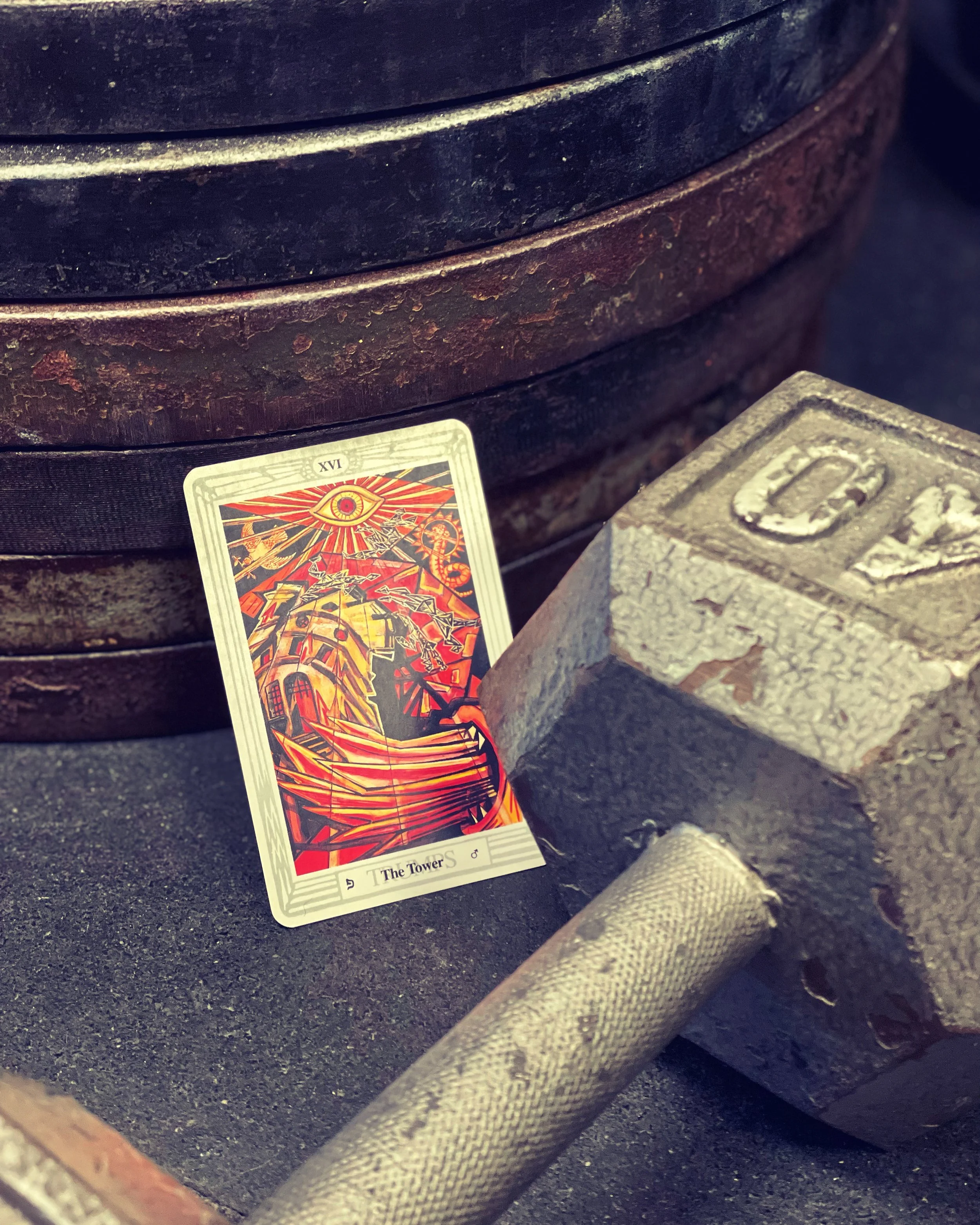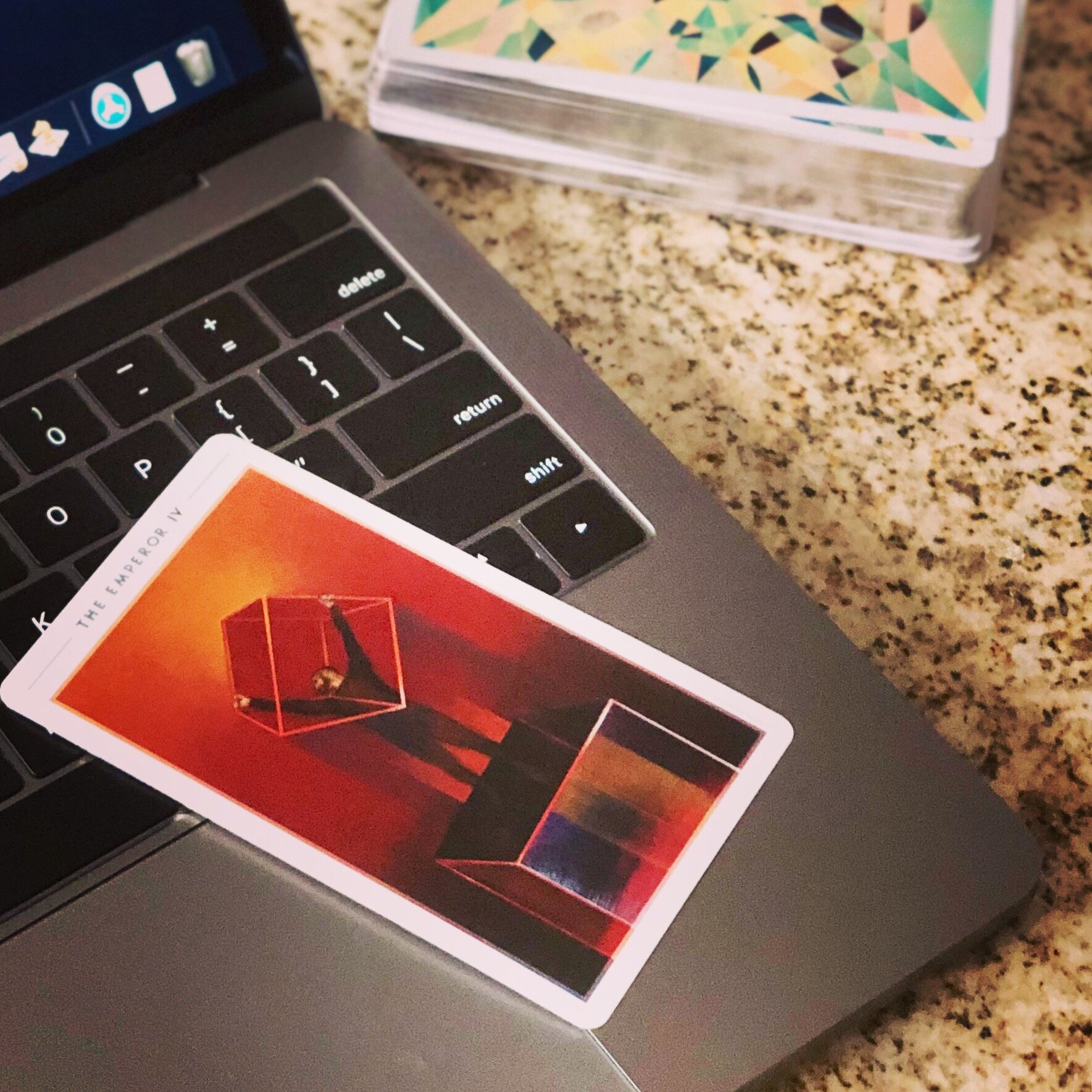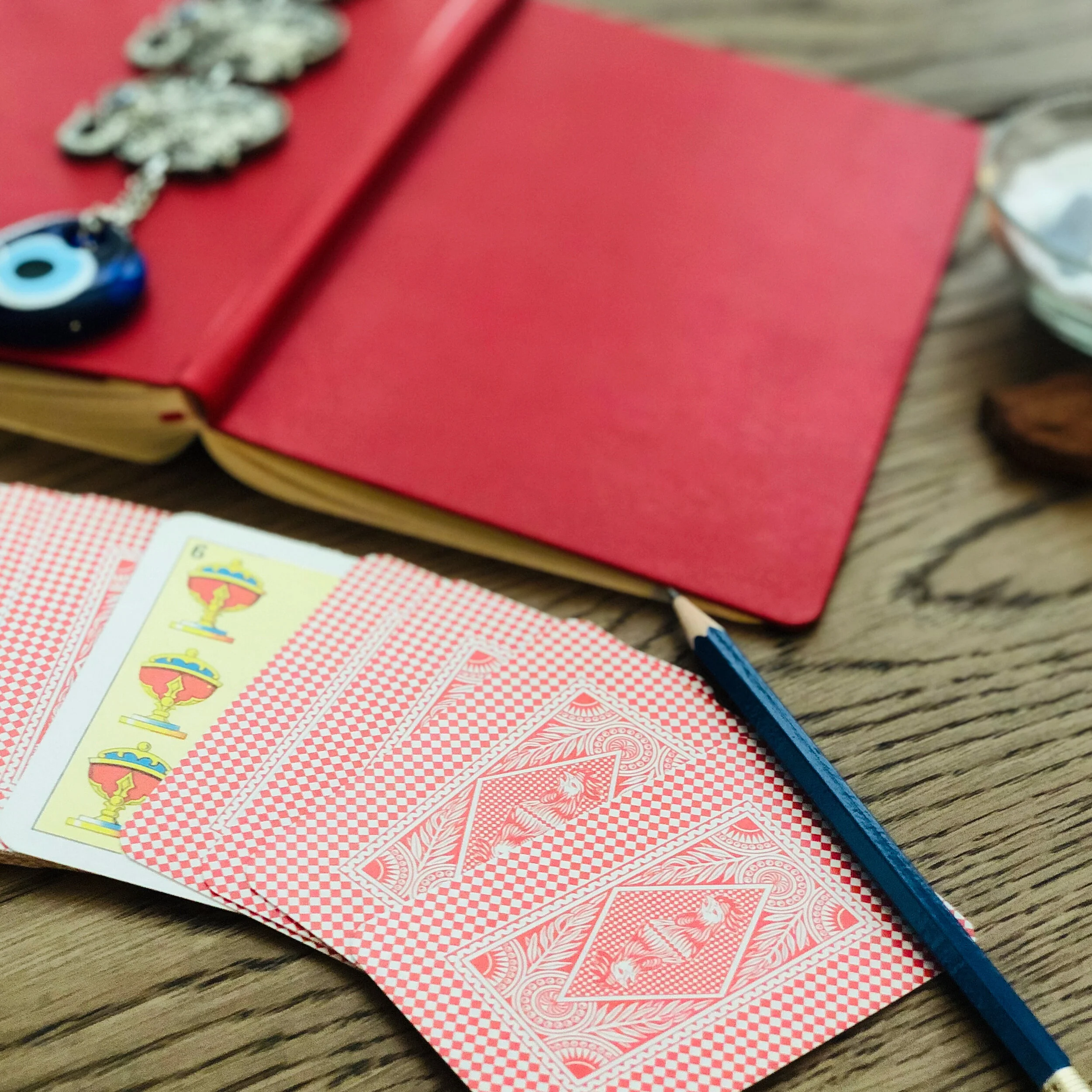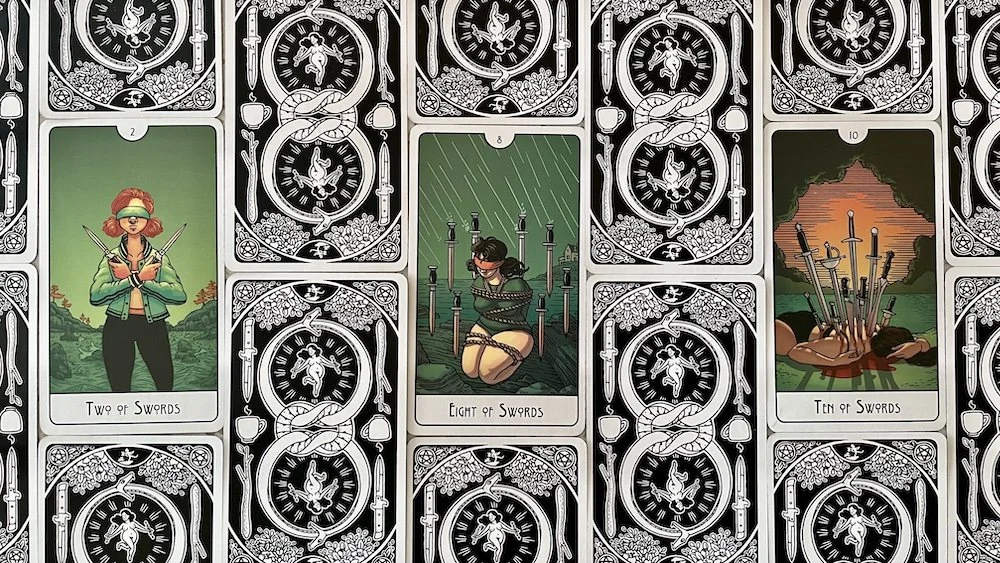Tarot, Coaching, and Fitness. What?
Let’s talk about 7 strategies that I learned from coaching at a gym that will help you become a better tarot reader.
That’s what blog headlines should sound like right?
As a coach, I help people meet their goals. I work alongside them, offering advice and strategies to help improve their performance and break through plateaus. Whether those opportunities and barriers present in the tarot salon or the gym doesn’t really matter as long as I, the coach, know what I’m talking about.
That’s not because clients in need of a tarot coach are the same as those in need of a fitness coach, at least not really. It’s actually because they’re different, just as two tarot clients or two fitness clients are different. A coach will likely do similar things for each of their clients in general terms, such as supporting them when they feel disappointed and challenging them to refine their techniques with specific exercises. But the specifics vary tremendously based on where the individual is and where they want to go in their practice. The content is sometimes less important than the context.
Before the instruction and the exercise, there’s an especially important place for coaching. It’s the place where goals, expectations, and parameters are all set. And unless you’ve worked with an experienced coach before, you probably haven’t had good guidance on setting that early foundation. That can make it hard to go it alone when the time comes. And being able to go it alone is key to sustainable development. Because if you can only make progress when you have your coach guiding each step of the way, you might be helping them more than they’re helping you.
Now you might not expect it, but having been a fitness coach helps me be a better tarot coach than I would otherwise be. Being a university instructor and a manager in different organizations has also given me many opportunities to refine the skills I use for coaching, but those are more obvious—to me, at least. But I wouldn’t have expected a gym to be a useful laboratory in preparing me to work with tarot clients. It definitely has been.
That’s because in fitness, it’s easy to identify measurable goals, and there are clear markers of progress toward those goals. Of course, there are intangible benefits, such as feeling better or having more energy throughout the day or the like. But when you can run a mile faster (or at all), that’s an obvious improvement. If you lose weight or body fat percentage, and if you can lift heavier weights or perform a new movement, that’s all very evident.
There may be some days when you’re slower than your goal or you don’t quite get that gymnastic movement, but if you have been able to do it, there’s less doubt that real progress was made.
Tarot is not usually like that.
But seven strategies that I have used time and again in the gym can work really well to help you improve your tarot practice.
Be consistent.
It’s hard to overstate how important consistency is. Consistency alone is not sufficient to becoming a good reader, but it is necessary. After all, you aren’t going to get better at something by not doing the work.
Consistency of practice has its greatest impact when that practice is designed to help you toward your goals. But consistent practice can help even when you have no clear focus or purpose. The advice for new tarot readers to draw a card daily is based on this idea.
That’s because pulling a card every day makes it a familiar practice. You get to know the cards, slowly but surely, and you get used to spending time with them. It all becomes normal for you, and when it’s normal to practice reading cards, it’s no longer a hassle or something that may be stressful and distracting.
You need to put safeguards and guidelines in place, just as you would when lifting weights or practicing gymnastics. But when you commit to showing up and then show up, you have the opportunity to make progress. Before then, it’s just an idea.
Set big goals and incremental goals.
Intermediate readers will often stop pulling a “card of the day” because it feels pointless. They’ve achieved the basic familiarization that the exercise provides, and they’re not sure what comes next. The intermediate reader can recognize a card as soon as they pull it. And they have an idea of what it could mean. That’s all that most readers get out of their card of the day, and it starts to feel empty.
But two valuable goals have been met. The intermediate reader has achieved the basic foundation of reading cards, and it’s worth recognizing that that’s useful and necessary to moving ahead to becoming a good tarot reader. It only feels empty because there’s no clear next step. The practice is part of an old goal, and it isn’t helping you progress much beyond your current state.
If you’re at the point where you find the card of the day to be a boring routine rather than something requiring thought, that’s a significant milestone. But a milestone is not a finish line. It’s just a point along the way that helps you recognize how far you’ve come and how far you have to go before reaching your destination. The goal to fluently recognize and interpret all of the cards in your deck may have been an explicit goal (or two) at one time, but now they’re past increments on the longer path. And there were probably increments along the way that you may or may not have recognized at the time. (Did you learn the majors first? Did you learn one suit earlier than another? Did you find meaningful shortcuts, such as using number patterns?)
So what's next? That’s up to you (or you and your coach). But your daily practice doesn’t have to be abandoned. You can certainly use what has become familiar to expand into new terrain.
What you want to achieve in the long run with your tarot reading will help you determine what comes next and how you can make incremental progress toward your bigger goal.
Record your performance.
There’s possibly nothing more maddening to a caring coach than someone who has no record of what they’ve done. Even a solid memory would be good. But so many readers pull cards (or lift weights) and then a week later have no idea what they did or how things turned out.
In the gym, this practice of recording helps you (and your coach) know whether something was sufficiently challenging or helpful in improving a skill, and that helps you reinforce that strength or shore up that weakness (possibly with a different technique). In tarot reading, recording your results will usually help you know how accurate your reading was and how easy it was to get that message. That can likewise help you reinforce or refine your skills.
Working with a coach 1:1 may mean that your coach is doing some of the recording on your behalf, but you should get in the habit of recording. Let your coach work themselves out of a job or at least out of your needing regular 1:1 sessions. We all need a little targeted help to get over that hump, but we shouldn’t need their constant help just to practice.
Side note. Actually writing your notes out by hand activates parts of your brain that are linked to memory, so I highly recommend that. But even a digital/typed record is useful.
Review your progress.
Whether you remember your reading or need to refer to your notes, make sure to review your records. It can be really validating to see when your readings proved useful. Of course that review will help you reinforce what you did well or work on the parts of your reading that didn’t serve the intended purpose. But even beyond that, it just feels good know when you have had valuable insights.
It can also help give you the confidence you need to read more fluently and to try more challenging readings. And it will be good to have the reason to continue with all of your hard work because you may not always think it’s worth the hassle.
Wanting to quit or feeling as if you’re not making progress is common, especially once you’ve burned through the early milestones. Whenever you’re learning something new or getting into new habits, you can hit new goals weekly or even daily. Later, it’s harder. That’s because you’ve collected all the low-hanging fruit.
Getting your first full push-up feels more satisfying than getting ten in a row for the first time, and it may take less time to achieve that first big milestone than the next one. The same may go for weight loss. Eventually you feel like you’ve hit a wall. And that’s when it’s especially valuable to have a long record to review. If you have records from a month ago or a year ago, you’ll see that this plateau is still significantly better than where you were a month or year ago.
Regularly assess against benchmarks.
Benchmarks give you a tangible measure of progress because they are static and comparable across time. How fast can you run a mile? What’s your blood pressure? What’s your resting heart rate? How much do you weigh and what’s your body fat percentage? These are all measurable, and they indicate different aspects of fitness. The values may go up or down (or oscillate) over time. But you the trend of your progress should be going in the right direction. If it’s not, you need to do something different.
Having benchmarks and assessing your performance against them allows you to review your progress with something measurable. This one may seem like a stretch for tarot readings—okay, this one is a stretch for tarot readings—but you can build your own kinds of benchmarks.
How quickly can you read a Celtic Cross (and make sense of it in regards to the reading) or how precisely can you read a Tarot Tableau? Can you summarize the energy of the Queen of Cups in three sentences? Can you come up with three occupations for the Knight of Pentacles? What about five? How many cards can you read into a succinct and coherent story? How few do you need to give a deep reading? If you do my Hermit’s Journey challenge from one year to the next, do your readings get deeper and make more sense over the years? Do you remember the decanic minors and relevant planets and meanings of the Lamp Lighter Challenge?
Any or all of these can be used as a benchmark if you find them to be valuable measures of your ability. What some people don’t realize about benchmarks is that not all of them are useful for all goals. Just because you can measure it doesn’t mean it’s a good measure for you.
Vary your practice.
Remember how I mentioned a lot of readers stop finding daily card pulls valuable? That’s because there’s not a new purpose to it anymore; it’s in desperate need of variety. Variety allows growth.
If you continue to pull one card a day every day for a year in response to the question, “What energy would it be good for me to embrace today?”, you may become very good at answering that question fluently and accurately using tarot cards. But you may struggle to answer the question, “What job experience would it be useful to highlight in this interview?” And you may struggle to interpret three cards that represent three distinct yet related areas of life. You may not need to answer those sorts of questions, but practicing answering them will help you understand how the cards offer different meanings in different contexts.
Similarly, if you only read for yourself or only for close friends or only for strangers, you may very well struggle to read for different audiences. You may not want to read for a different audience, but being able to do so will help you read better overall. And chances are good that you’ll learn things about your preferred way of reading that can be improved or broadened.
Varying your practice goes beyond tarot as well. Explore other forms of divination from time to time. See how you read tea leaves or paint splotches or oracle cards. How could they help you answer questions in a different way from tarot and how might they help you meet your own tarot-reading goals? Learning how to do a handstand might not seem like it will help you do a pull-up, but it gives your body and brain something different to do while still developing related muscles. There are so many unexpected connections that can be made in our brains and bodies, in athletic skills and in tarot skills.
Seek external feedback (and incorporate it when appropriate).
There’s only so much we can do on our own, and while it’s rare that someone else can fully read our cards for us, they can still help remind us of forgotten meanings or make connections we missed or uncover hidden treasures. They can ask tough questions and force refinement of vague readings. They can also support you when you are uncertain that what you’re intuiting is correct, even when you can’t explain it. They can also provide you with new resources, techniques, tools, and the like. All of these help you grow in your practice. And of course if you’re reading for others, getting feedback from others will help you improve your delivery of the messages you receive.
You can do this through social media posts or by sharing your readings with friends and fellow readers. You can conduct free readings in exchange for feedback or ask paying clients to help you determine what was accurate in your reading (then and later) and what was unclear in your explanation. You can set up study groups and practice sample readings on fictional scenarios. You can take a class or set up private mentoring and coaching.
But as you’re learning from others and getting feedback on your readings from others, remember that they can’t do the work for you and that they aren’t in the same intuitive space as you. It might turn out that they were “right” when all is said and done, but you shouldn’t give your authority over to them. You have to decide what of their feedback will help you in your practice and when it will help to incorporate it. Sometimes good advice comes at a bad time. And sometimes excellent readers can’t actually explain what they’re dong—or even know what they’re doing in a conscious way—so their advice won’t always be helpful. But it’s still good to seek out feedback from appropriate sources occasionally. It can be affirming and humbling, and either way, there’s lots to learn.
Just make sure to respect other people’s boundaries. Some people don’t want to take about what’s going on in their lives after a reading that feels personal. That’s their prerogative. Some people love jumping in to give feedback on others’ readings. But others, such as I, enjoy doing that only for their students and close friends but cannot take that time for everyone outside of paid sessions.
There are other strategies that my experience in coaching at a gym can provide my tarot coaching clients, but it’s good to remember that everyone needs something different. General advice can only take you so far. But why not see how far these strategies can take you? And do please let me know if you’re able to use them on your own to make strides or if you need a little extra coaching.




